This is what I have wondered for most of my diving career.
The 6th edition of Ruppert/Barnes Invertebrate Zoology textbook published in 1994 seemed to make it pretty clear: “Hermit crabs always use empty shells and never kill the original occupant.”
So did the 7th edition published in 2004: “These distinctive decapods appropriate discarded snail shells for use as portable domiciles.”
Then a couple months ago I came upon this scene.
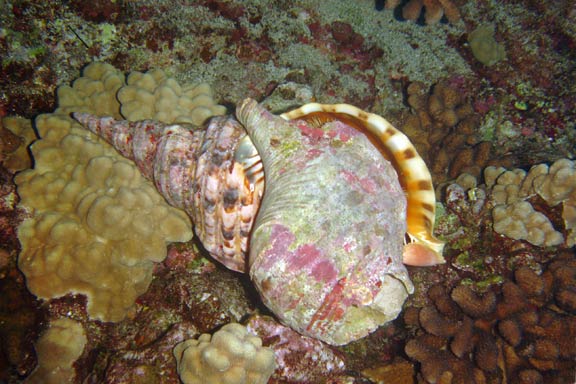
A yellow hairy hermit crab (Aniculus maximus), in a scrappy remnant of a triton’s trumpet shell, was reaching way into the opening of a beautiful intact triton’s trumpet (Charonis tritonis) shell. What was going on in there?? Was the triton snail alive and in its home shell? Or was the shell empty? Was there another hermit crab already occupying the shell?
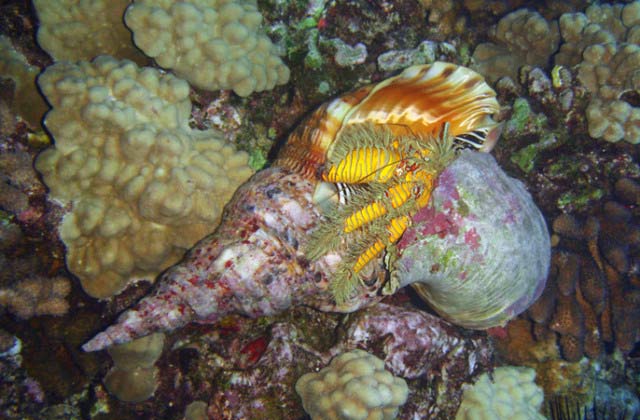
I moved the hermit crab aside and, after convincing myself that the shell was not occupied by a hermit crab, reached in and felt the snail completely retracted, with the operculum (trap door) tightly sealing the opening. Since it takes energy to hold the operculum tight, I knew that the triton snail was still alive.
So, what was the hermit crab trying to do? Clearly it was in need of a new shell because it was exposed from the rear by the broken apex of the shell. Was it just inspecting the shell to see if it was occupied? Or did it have a darker plan? Since there was no way to know, we had to continue on our dive with our questions unanswered.
When I got home I Googled “Do hermit crabs kill snails for their shells.” Many aquarists reported hermit crabs killing snails in their tanks as a common occurrence, mostly to eat the snails, but sometimes occupying the shells as well. Is this behavior a result of being held in captivity where food availability, shell availability and snail refuge options are not representative of those found in the wild? Or is this normal behavior that happens in the wild as well?
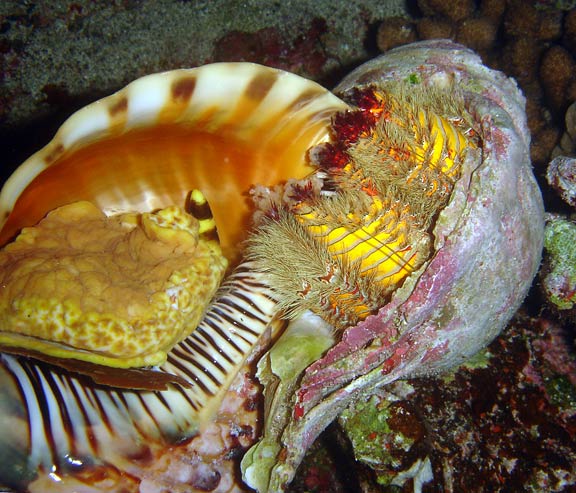
The next day by chance we ended up diving in the same location. I had no expectation of seeing the animals again, but as we approached the ledge, there they were in exactly the same place. As we got closer though, we could see that something was different. The hermit crab still had its claws inside the opening of the shell, but not as far in as yesterday because the triton snail was protruding from the aperture – and was motionless. The hermit crab, with its claws full of snail flesh, had apparently killed the snail!
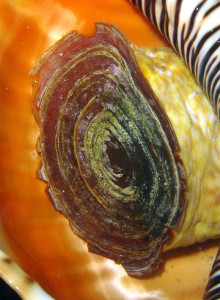 Looking more closely, the operculum had small chips all around the edge, indicating that the hermit had been attempting to gain access to the snail by picking away at the operculum with its claws.
Looking more closely, the operculum had small chips all around the edge, indicating that the hermit had been attempting to gain access to the snail by picking away at the operculum with its claws.
The following day when we returned to the site, all the participants were gone. Since the triton snail was dead and could no longer crawl away on its own, we theorize that the hermit crab was able to remove the dead snail, occupy the shell and carry it away.
To find out if anyone else had seen anything like this, I asked people who I knew had been diving a really long time and were known for paying particular attention to what they saw. Not surprisingly, Linda Marsh, a divemaster with over 15,000 dives in Hawaiian waters and owner of Kauai dive operation Bubbles Below, had had a similar, but more “interactive,” encounter over a period of five days.
Linda’s yellow hairy hermit crab was in an old partridge tun shell, and when she found it trying to get at a triton’s trumpet snail she actually separated them and swam the hermit crab about 100 yards away. The next day, however, it was right back on the triton snail! She separated them again on two more days, each time swimming the hermit far away, but the following day the hermit would be back on the triton, digging around the operculum. Eventually within a 24-hour period the hermit successfully killed the triton snail and she saw it occupying the triton’s shell.
With this evidence, I contacted Dr. Brian Hazlett, hermit crab expert and Professor Emeritus of Ecology and Evolutionary Biology at the University of Michigan. He was aware of only one report in the literature of a hermit killing a snail and occupying the shell. Another researcher, Edwin Iverson, also was aware of only one example in the literature.
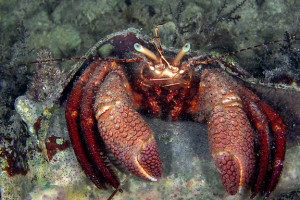
Giant Hermit Crab (Petrochirus digenes)
Photo by Keoki Stender.
The paper they cited was one published by Dr. Jack Randall (yes, world-reknowned fish biologist) FIFTY years ago. In that paper Dr. Randall described a long-term study in St. John, Virgin Islands where he and some colleagues built a fence around an elliptical area of seagrass and sand that housed numerous queen conchs they had tagged. One day they found one of their tagged conchs missing, and in its place an empty eroded queen conch shell that had not been inside the enclosure initially. Later they watched as a hermit crab, Petrochirus diogenes, attacked a queen conch, and subsequently occupied the queen conch’s shell. They determined that this species of hermit had climbed the fence, consumed one of the conchs, moved into its shell and climbed out of the enclosure, leaving its old shell behind. In total six of their tagged conchs were killed and occupied by this species of hermit crab.
Our question had finally been answered. At least two species of hermit crab (Aniculus maximus in Hawaii and Petrochirus diogenes in the Caribbean) kill snails for their shells.
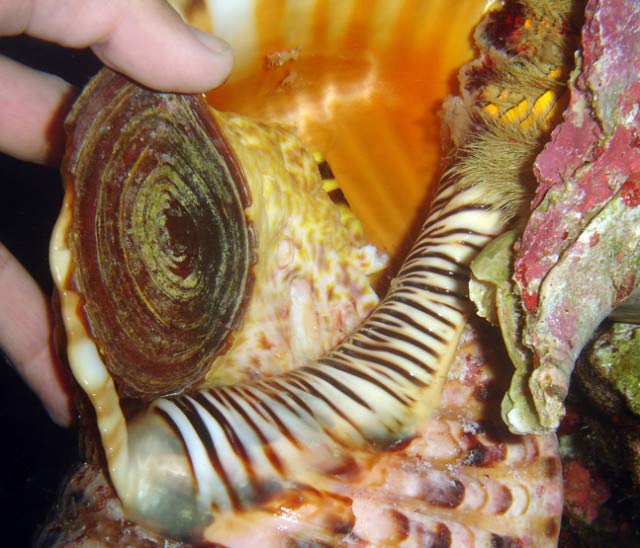
But one question answered invariably begs numerous follow-up questions. For me, one of these is how did the hermit crab kill the triton snail? As you can see in the photo to the left, other than a few small gouges out of the snail, there is no obvious cause of death. One possibility is that the triton snail, being forced to remain fully retracted in it shell, could not effectively circulate enough water across its gills and died from lack of oxygen. Or, the muscular tension required to keep the operculum tightly sealed could have led to anaerobic metabolism and lactic acid build-up, something that might have reached toxic levels. Either of these or the combination of them could have led to the death of the triton snail, and once the snail’s muscles relaxed, the crab could have consumed the original builder and moved into its beautiful new home.
*****************
Written by Pauline Fiene. Photos by Pauline Fiene unless otherwise credited. Mahalo to John Hoover, Dr. Brian Hazlett and Cory Pittman for discussion and insights; to Warren Blum for underwater observations, to Keoki Stender for generous use of his Petrochirus diogenes photo; and to Linda Marsh for her recounting of such a fabulous and rare multi-day encounter.
Iverson, Edwin S. 1986. Predation on Queen Conchs. Strombus gigas, in the Bahamas. Bull. Mar. Sci. 39(1): 61-75.
Randall, J. E. 1964. Contributions to the biology of the queen conch, Strombus gigas. Bull. Mar. Sci. Gulf Carib. 14: 246-295.

Comments 8
I’ve read this article now at least twice, and each time I find it fascinating. Thanks for sharing this wonderful piece of research with us, Pauline.
I have a picture I took back in March, of a giant Caribbean hermit crab (wearing a conch shell) preying on a tulip snail.
Hi Kathy, I’m currently writing an article for a marine aquarist’s magazine in the UK on hermit crabs. Would you be willing to let me see your picture and possibly use it in the article. It would be ascribed to you of course.
Regards,
Campbell Robertson
Just got back from snorkeling, here in St Thomas. I just watched what looked like a giant spotted hermit crab attacking a conch shell. The crab had both its claws deep inside the shell while holding the shell in place with its other legs. I could sneak a peek inside the shell as it was quite large and I could see a dark mass deep inside the shell. That must have been the conch. They stayed in that position for at least a half an hour but as it was getting dark I left. I will go back tomorrow and see if I can find them again.
Very cool! Thanks for sharing. I’ll look forward to hearing what you see tomorrow.
Update: The crab and shell were not in the same place anymore. However I dove up and down the grassy area and I found the hermit crab again. It was definitely living in a different conch shell as the previous one was smaller as well as all white and old looking whereas the new one or the one I saw it in had a pretty orange coloring on its inside and more defined spikes. I am pretty sure it’s the same crab now living in the conch I saw yesterday. I wish I marked both!!! How fascinating it would be to have definitive proof.
(Given it could be a different crab altogether however I have been snorkeling here for a week now and only ever saw one at a time so chances are pretty good that it’s the same one. )
Fascinating. Thank you, Cat.
Pingback: March Hermits in Medium Size Horse Conch – Seashells by Millhill